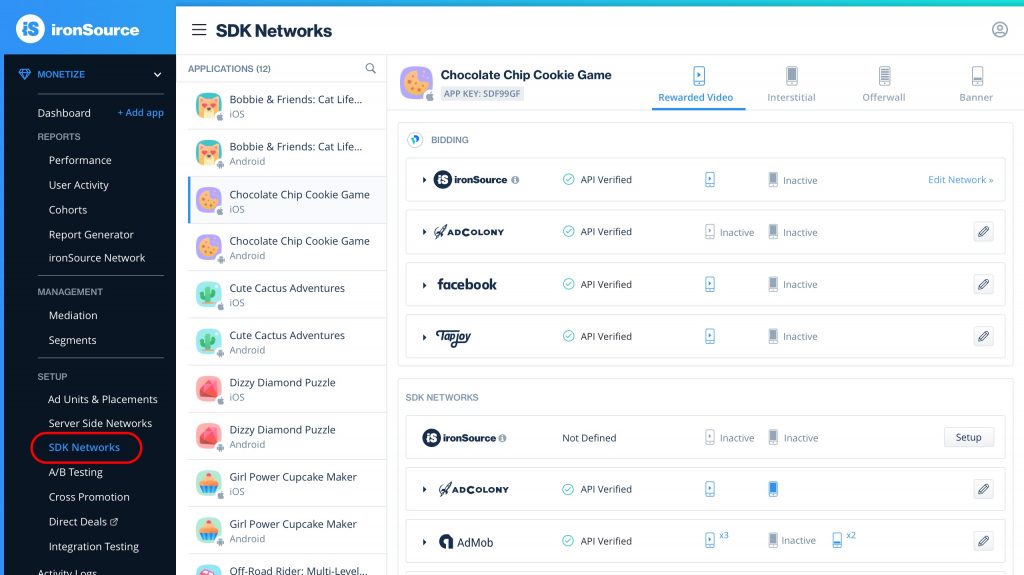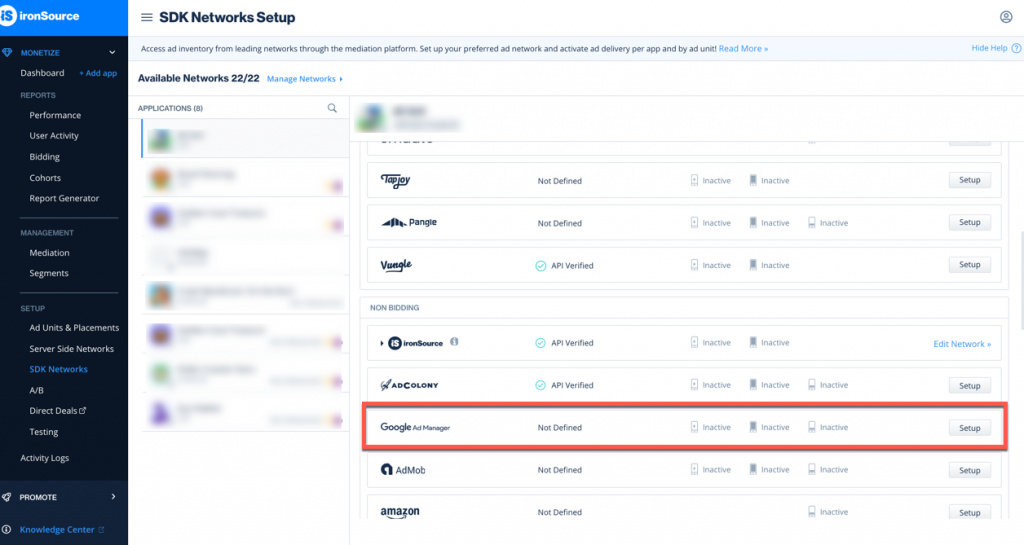Google Ad Manager integration guide
Follow these instructions to set Google Ad Manager live as an ad network on the Unity LevelPlay mediation.
Google Ad Manager ads are served using the AdMob SDK.
As of AdMob SDK 7.69.0+, AdMob are using XCFramework. If you are using CocoaPods for your AdMob integration, make sure you have CocoaPods Version 1.9.0+.
AdMob Supports Android Operating Systems Version 4.1 (API level 16) and up. The required Gradle Build Tool is 3.5.4.
You can learn about the support for AndroidX here.
AdMob SDK supports iOS version 10+, and will server ads for users on iOS version 11+.
Step 1. Create a Google Ad Manager account
- To access Google Ad Manager ad inventory through Unity LevelPlay’s mediation, create an Ad Manager account.
- In order to monetize with Google ad manager, Google AdSense account need to be created
- Connect your AdSense account to your Ad Manager account
Step 2. Create Inventory in Google Ad Manager
- Google AdManager guide can be found here
- Orders:
- Add at least one order
- Connect your AdSense as an Advertiser to the order
- Line Items
- Inside the desired order, Add a Line Item for each ad unit you are looking to monetize (Int / RV / BN / NTV BN)
- Select video Line item
- Line item type = Ad exchange
- Apps
- The application should be added automatically from your Admob account
- If not, create a new application (Inventory > Apps > Add app)
- Ad unit
- Add ad unit for each price point
Step 3. Activate Google Ad Manager in your ironSource account
Sign in to your Google account when setting up Ad Manager on the ironSource SDK Networks Setup page. This will ensure that all of the necessary parameters to run Ad Manager’s interstitials, rewarded videos, and banners will be automatically retrieved.
- In your Google Ad Manager account, obtain the following information:
| App ID | The unique ID assigned to your app on the Ad Manager dashboard |
| API Key | The unique identifier for your Ad Manager account. This allows the Unity LevelPlay Mediation to import performance data from your Ad Manager account to use in reporting and optimization |
| Ad Unit ID | The unique ID assigned to your app’s ad unit on the Ad Manager dashboard |
| Client ID | The unique identifier that specifies the relationship between your account and the ad unit |
| Client Secret | The secret key that pairs with the Client ID |
| Refresh Token | The refresh token the client application already received |
2. Configure Google Ad Manager’s parameters in your ironSource account.
- Log in to your ironSource account and go to ‘Monetize‘ ➣ ‘SETUP‘ ➣ ‘SDK Networks‘.

- Select Google Ad Manager from the list of Available Networks and enter the Ad Manager’s API Key, Client ID, Client Secret, and Refresh Token; or click the Login with Google option.

Login with Google

Click Save. Ad Manager will be enabled and listed in the Available Ad Networks table.

- Select the app on which you’d like to run Unity LevelPlay’s Mediation with Ad Manager.
- Select Ad Manager from the setup list of ad networks and click on the tool Define button. Insert the App ID and Ad Unit ID under interstitial, rewarded video or banner settings.

- Verify your integration with the Reporting API. This column will check your integration through the Reporting API and return three possible responses: Verified, Failed, and No Response. If you do not see Verified, double check your integration and the information you entered, then click Retry until you see Verified.
Step 4. Add the Admob Adapter to Your Build
Unity Integration Manager (Recommended)
Once you’ve completed SDK integration, you can download AdMob Adapter, using the Unity Integration Manager.
In your Unity Development platform, go to Ads Mediation > Integration Manager.
If you already have the latest version of the adapters, the action button will be changed to “Updated”, and will be disabled.
Android (Manual Resolve)
To apply your changes, make sure you use the “Resolve” process. This will download all relevant artifacts, according to your choices. For detailed information see instructions here.
Add AdMob App ID
Android
As of V17.0.0 (Adapter version 4.3.1 onwards), AdMob’s SDK requires publishers to add their AdMob App ID to the app’s AndroidManifest as a child of the <application></application> tag:
<meta-data android:name="com.google.android.gms.ads.APPLICATION_ID"
android:value="[ADMOB_APP_ID]"/>
Replace the “[ADMOB_APP_ID]” with the APP ID value you retrieved in step 3.
Not doing so results in crashes originated with AdMob’s SDK. For more information please refer to AdMob’s guide.
iOS
As of V7.42.0 (Adapter version 4.3.3 onwards), AdMob’s SDK requires publishers to add their AdMob App ID to the app’s plist as described here.
Alternatively, you can make this change programmatically
<key>GADApplicationIdentifier</key> <string>[APP_ID]</string>
Replace the “GADApplicationIdentifier” value with the APP ID value you retrieve in step 3.
Android Plugin Manual Integration
- Download the Admob Adapter for Android:
Download AdMob adapter and AdMob SDK (AAR) from here. - Add the Admob files to your Unity project:
Import the files into Assets/Plugins/Android/. - Add the manifest activities noted in the Android documentation.
- Add AdMob App ID to the app’s AndroidManifest as a child of the
<application></application>tag:
<meta-data android:name="com.google.android.gms.ads.APPLICATION_ID" android:value="[ADMOB_APP_ID]"/>Replace the “[ADMOB_APP_ID]” with the APP ID value you retrieved in step 3.
Not doing so results in crashes originated with AdMob’s SDK. For more information please refer to AdMob’s guide.
iOS Plugin Manual Integration
- Download the AdMob iOS Adapter:
Download AdMob adapter and AdMob SDK from here. - Add the AdMob adapter to your Unity project:
Import AdMob adapter file into Assets/Plugins/iOS. - Add the SDK to your Xcode project:
As Unity3D does not support XCFrameworks, please add the SDK XCFrameworks directly to your Xcode project. - Add your AdMob App ID to the app’s plist as described here.
Alternatively, you can make this change programmatically
<key>GADApplicationIdentifier</key> <string>[APP_ID]</string>
Replace the “GADApplicationIdentifier” value with the APP ID value you retrieve in step 3.
Step 5. Additional Steps
Child-directed setting – COPPA
Unity LevelPlay’s mediation lets publishers communicate AdMob Child-directed settings directly to the AdMob network.
This feature is enabled using ironSource SDK 6.14.0+, AdMob Unity Adapter 4.3.12+.
Use the following syntax, to set AdMob setTagForChildDirectedTreatment with the parameter “True”:
IronSource.Agent.setMetaData("AdMob_TFCD","true");
Use the following syntax, to set AdMob setTagForChildDirectedTreatment with the parameter “False”:
IronSource.Agent.setMetaData("AdMob_TFCD","false");
To learn more about Child-directed settings Under AdMob network visit here.
Users under the age of consent – GDPR
Unity LevelPlay’s mediation lets publishers communicate with AdMob network, a Tag For Users under the Age of Consent in Europe (TFUA) request.
This feature is enabled using ironSource SDK 6.14.0+, AdMob Unity Adapter 4.3.12+.
Use the following syntax, to set setTagForUnderAgeOfConsent with “True”:
IronSource.Agent.setMetaData("AdMob_TFUA","true");
Use the following syntax, to set setTagForUnderAgeOfConsent with “False”:
IronSource.Agent.setMetaData("AdMob_TFUA","false");
To learn more about Child-directed settings Under AdMob network visit here.
Ad Content filtering
Unity LevelPlay’s mediation lets publishers communicate with AdMob network, maximum ad content rating for all ad requests.
This feature is enabled using ironSource SDK 7.12.0+, AdMob Android Adapter 4.3.23+.
Use the following syntax, to set maxAdContentRating:
IronSource.Agent.setMetaData("AdMob_MaxContentRating","MAX_AD_CONTENT_RATING_G");The possible values for this property are based on digital content label classification as defined by Google:
- MAX_AD_CONTENT_RATING_G
- MAX_AD_CONTENT_RATING_PG
- MAX_AD_CONTENT_RATING_T
- MAX_AD_CONTENT_RATING_MA
To learn more about Ad Content Rating property Under AdMob network visit here.
Content URL mapping support
Unity LevelPlay supports Google’s content mapping for apps, and allows you to share URLs using “Google_Content_Mapping” settings. This feature is enabled using ironSource SDK 7.7.0+, AdMob Adapter 4.3.58+. Learn more about Google’s content mapping here.
To pass a single-content URL, use the following syntax:
IronSource.Agent.setMetaData("Google_Content_Mapping","https://www.example.com");To support multiple urls, use the same key and share up to 4 URLs:
IronSource.Agent.setMetaData("Google_Content_Mapping",["https://www.expamle1.com","https://www.example2.com"]);Verify Your Ad Network Integration
The ironSource SDK provides an easy way to verify that your mediation integration was completed successfully. To verify your ironSource SDK and additional Ad Networks’ integration, follow this document.
Done!
You are now all set to deliver Google Ad Manager within your application!
What’s Next?
To leverage additional mediation ad networks, integrate the adapters and follow our integration guides.
